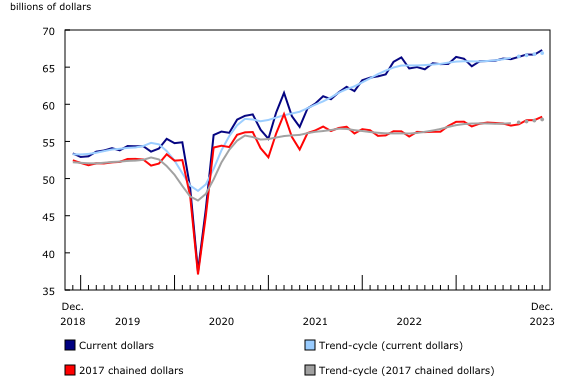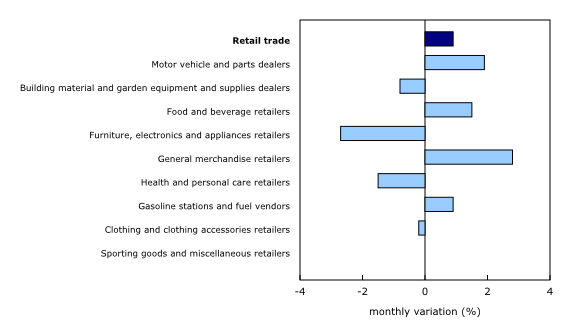Retail trade, December 2023
Released: 2024-02-22
$67.3 billion
December 2023
0.9% 
(monthly change)
$1.0 billion
December 2023
-0.0% 
(monthly change)
$0.3 billion
December 2023
-3.3% 
(monthly change)
$1.8 billion
December 2023
1.3% 
(monthly change)
$1.5 billion
December 2023
0.8% 
(monthly change)
$15.0 billion
December 2023
0.2% 
(monthly change)
$25.3 billion
December 2023
1.3% 
(monthly change)
$2.3 billion
December 2023
0.2% 
(monthly change)
$2.1 billion
December 2023
1.0% 
(monthly change)
$8.6 billion
December 2023
0.9% 
(monthly change)
$9.3 billion
December 2023
1.5% 
(monthly change)
$0.1 billion
December 2023
2.4% 
(monthly change)
$0.1 billion
December 2023
1.2% 
(monthly change)
$0.1 billion
December 2023
4.5% 
(monthly change)
Retail sales increased 0.9% to $67.3 billion in December. Sales were up in five of nine subsectors and were led by increases at motor vehicle and parts dealers (+1.9%).
Core retail sales—which exclude gasoline stations and fuel vendors and motor vehicle and parts dealers—were up 0.5% in December.
In volume terms, retail sales increased 0.8% in December.
Retail sales were up 1.0% in the fourth quarter of 2023, marking a second consecutive quarterly increase. In volume terms, retail sales increased 1.3% in the fourth quarter.
In 2023, retail sales increased 2.2%, led by gains at motor vehicle and parts dealers. In volume terms, sales were up 2.3% in 2023.
Sales at motor vehicle and parts dealers rise
The largest increase in retail sales in December was observed at motor vehicle and parts dealers (+1.9%), up for a fourth consecutive month. The gain in December was led by higher sales at new car dealers (+2.4%). The largest decline in this subsector came from automotive parts, accessories and tire retailers (-2.7%).
Sales at gasoline stations and fuel vendors (+0.9%) were also up in December. In volume terms, sales at gasoline stations and fuel vendors increased 2.1%.
Core retail sales rise on gains at general merchandise retailers
Core retail sales increased 0.5% in December, led by higher sales at general merchandise retailers (+2.8%) and food and beverage retailers (+1.5%). Sales at food and beverage retailers were up from higher sales at supermarkets and other grocery retailers (except convenience retailers) (+1.8%) and, to a lesser extent, specialty food retailers (+3.1%).
The largest decrease to core retail sales in December came from furniture, home furnishings, electronics and appliances retailers (-2.7%).
Sales up in eight provinces
Retail sales increased in eight provinces in December, led by higher sales in Ontario (+1.3%) and, to a lesser extent, British Columbia (+1.5%).
In Ontario (+1.3%), retail sales were up in December on the strength of higher sales at motor vehicle and parts dealers. In the census metropolitan area (CMA) of Toronto, retail sales were up 0.6%.
Retail sales in British Columbia (+1.5%) rose in December, led by higher sales at food and beverage retailers. In the CMA of Vancouver, retail sales were up 1.5%.
The largest provincial decrease in retail sales in December was observed in Prince Edward Island (-3.3%). The decrease was led by lower sales at gasoline stations and fuel vendors.
Retail e-commerce sales in Canada
On a seasonally adjusted basis, retail e-commerce sales were down 3.6% to $3.7 billion in December, accounting for 5.5% of total retail trade, compared with 5.8% in November.
Retail sales in 2023
Canadian retailers finished 2023 with $794.4 billion in sales, up 2.2% from 2022 with increases observed in five of nine subsectors. Leading the gain in retail sales in 2023 were higher sales at motor vehicle and parts dealers (+7.0%), which were driven by gains at new car dealers (+8.7%) and coincided with improved supply chains and inventories compared with 2022. The largest decrease to retail sales in 2023 was observed at gasoline stations and fuel vendors (-9.9%), largely the result of lower gasoline prices in 2023 compared with 2022. In volume terms, sales at gasoline stations were up 9.7% in 2023.
Core retail sales increased 2.4% in 2023, led by higher sales at food and beverage retailers (+3.7%) and health and personal care retailers (+8.6%). Sales at food and beverage retailers were up from higher sales at supermarkets and other grocery retailers (except convenience retailers) (+5.5%), which saw gains in eight months in 2023.
Advance retail indicator
Statistics Canada is providing an advance estimate of retail sales, which suggests that sales decreased 0.4% in January 2024. Owing to its early nature, this figure will be revised. This unofficial estimate was calculated based on responses received from 52.7% of companies surveyed. The average final response rate for the survey over the previous 12 months was 88.3%.
Did you know we have a mobile app?
Get timely access to data right at your fingertips by downloading the StatsCAN app, available for free on the App Store and on Google Play.
Note to readers
All data in this release are seasonally adjusted and expressed in current dollars, unless otherwise noted.
Seasonally adjusted data are data that have been modified to eliminate the effect of seasonal and calendar influences to allow for more meaningful comparisons of economic conditions from period to period. For more information on seasonal adjustment, see Seasonally adjusted data – Frequently asked questions.
The percentage change for the advance estimate of retail sales is calculated using seasonally adjusted data and is expressed in current dollars.
This early indicator is a special unofficial estimate being provided to offer Canadians timely information on the retail sector. The data sources and methodology used are the same as those outlined on the Monthly Retail Trade Survey information page.
Trend-cycle estimates are included in selected charts as a complement to the seasonally adjusted series. These data represent a smoothed version of the seasonally adjusted time series and provide information on longer-term movements, including changes in direction underlying the series. For information on trend-cycle data, see Trend-cycle estimates – Frequently asked questions.
Both seasonally adjusted data and trend-cycle estimates are subject to revision as additional observations become available. These revisions could be extensive and could even lead to a reversal of movement, especially for the reference months near the end of the series or during periods of economic disruption.
Seasonally adjusted estimates for cannabis store retailers are presented in unadjusted form, as no seasonal pattern has been established by official statistics yet. Establishing such a pattern requires several months of observed data. In the interim, the seasonally adjusted estimates for cannabis store retailers will be identical to the unadjusted figures.
Some common e-commerce transactions, such as travel and accommodation bookings, ticket purchases and financial transactions, are not included in Canadian retail sales figures.
Total retail sales expressed in volume terms are calculated by deflating current-dollar values using consumer price indexes.
Find more statistics on retail trade.
Next release
Data on retail trade for January will be released on March 22.
Contact information
For more information, or to enquire about the concepts, methods or data quality of this release, contact us (toll-free 1-800-263-1136; 514-283-8300; infostats@statcan.gc.ca) or Media Relations (statcan.mediahotline-ligneinfomedias.statcan@statcan.gc.ca).
- Date modified:


